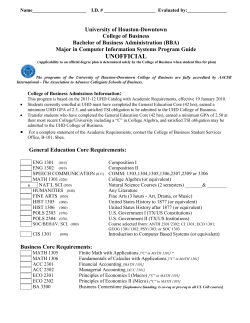
Retail markets in the CIS and Baltic States: main
Retail markets in the CIS and Baltic States: main characteristics and the future trends 4th Annual Russian Retail Forum Dr. Olga Sagirova, Principal, Roland Berger Strategy Consultants Moscow, 4th April 2005 Final_29_03_color 1 1 Market environment 2 Does political and economic climate stimulate overall business development in the CIS and Baltic States? Market attractiveness Are the retail markets in the CIS and Baltic States attractive from the standpoint of formats and retail development? CIS retail market What future trends determine the market development? 3 Market trends Who are the main interest groups in the retail markets of CIS and Baltic States? What are their key issues? 4 Market players Final_29_03_color 2 1 CIS and Baltic states is a diverse region both in terms of economic and political development Comments Political stability Estonia Latvia High Russia Lithuania Kazakhstan • In terms of GDP per capita Baltic States are reaching Eastern European levels, while Russia will soon reach levels comparable to Poland and Hungary in 2000 Ukraine Georgia Belarus Turkmenistan Tajikistan Uzbekistan Armenia Kyrgyzstan Azerbaijan Low Moldova 50 100 GDP per capita Source: statistical offices of the countries, EIU, Roland Berger analysis 300 • All the countries of CIS and Baltic States have been recovering from the crisis caused by the collapse of the Soviet Union – 1995 has been the turning point in GDP development – according to the official statistics, GDP has been growing in the region since then 500 GDP [bn USD] • Change of the ruling regimes has started in Georgia with “rose” revolution – the case has been followed by Ukraine and Kyrgyzstan Final_29_03_color 3 2 CIS and Baltic states contribute together to less than 3 % of world retail – of which Russia is responsible for almost three quarters Retail market worldwide – regional segmentation, [bn. USD] 100% = 9,236 Western Europe 29% Northern America Latin America + 5% Caribbean 4% Eastern Europe 27% 5% Africa 30% Asia Pacific and Australasia - CIS and Baltic States (in Eastern Europe and in Asia) Retail markets – CIS and Baltic States, 2004 [bn. USD] Russia Ukraine Belorussia Kazakhstan Lithuania Uzbekistan Latvia Azerbaijan Estonia Georgia Armenia Kyrgyzstan Moldova Tajikistan Turkmenistan 198.1 23.7 8.1 7.2 7.2 6.41) 4.9 3.4 2.41) 1.7 1.3 0.9 0.6 0.6 n.a. 1) 2001 Source: Euromonitor, statistical offices of the countries, EIU, Roland Berger analysis Final_29_03_color 4 2 Russia and Ukraine are not only the biggest retail national markets – they also have significant potential in the regions Retail centralization: CIS and Baltic states National retail volume [bn USD) 180 Decentralized retail markets Centralized retail markets Moscow 25 Kiev 10 Minsk Tashkent Vilnius Riga Astana & Alma-Ata Bishkek 15% Source: EIU, Statistical offices of the CIS countries Baku Dushanbe Ashgabat Chisinau 30% Tallinn Tbilisi 45% 60% Share of retail sales in the capital in the overall retail Final_29_03_color 5 2 Baltic states have established retail markets – many CIS national markets are comparable to Russian regions in many terms Retail volume and GDP per capita, share of institutional trade 10 biggest Russian regions by retail turnover, 2003 [USD bn] Retail volume per capita [‘000 USD] Moscow 3.5 38.0 Moscow 2.5 Latvia Tyumen Samara 1.5 Estonia Lithuania Tiumen 3.5 Krasnodar 3.4 Yekaterinburg 3.4 Rostov-Don 3.2 Russia Perm Kazakhstan St. Petersburg Ukraine 0.5 Uzbekistan Armenia Belarus Kyrgyzstan Azerbajan Georgia Tadjikistan Moldova Turkmenistan >5% >40% 5.0 St-Petersburg Share of institutional trade Ufa 2.6 Nizhnij Novgorod 2.4 Krasnojarsk 2.4 Cheliabinsk 2.2 GDP per capita Source: EIU, Statistical offices of the CIS countries Final_29_03_color 6 3 Rise of economic well-being clearly fasters a shift towards nonfood in overall expenditures of population Share of food1) expenditures in net income, 2003 GDP, p.F.2) 1.2 0.3 0.3 67 66 65 1.5 58 1.0 0.4 1.3 3.4 50 49 48 2.3 2.7 46 46 0.7 6.3 42 42 5.4 8.1 5.9 4.6 40 40 4.3 1) food, beverages and tobacco 2) ‘000 USD Source: CIS Statistics office, EIU 6.4 25 26 27 CZ Hun. PL 36 27 Uzb. 10.3 55 32 Armen. Tadj. 10.3 Ukr. Azerb. Kyrg. Georg. Rus. Belor. Kaz. Moldova Lith. Latv. Eston. CZ Hun. 2000 PL 2004 Final_29_03_color 7 3 Consumer behavior in the CIS countries is likely to change slowly in terms of price orientation, mobility and shopping patterns Consumer behaviour patterns in different regions CIS Baltic States, Eastern Europe Western Europe • Stronger price sensitivity due to generally lower income – only selected niches for valueadded retailing • Price orientation remains strong; shopping for fun and pleasure are getting grounds • Strong polarization towards price orientation on the one hand and luxury on the other hand • Most of the purchases in most of the countries is done at the street markets • Higher share of daily shoppers due to expenditure limits and missing storage opportunities Source: Roland Berger analysis • Street markets are losing importance, as number of auto owners is growing • Shopping-rhythm is slowing down – growing share of weekend shoppers • High share of big shopping venues outside of city centers and living areas • High share of weekendshoppers with high share of non-food Final_29_03_color 8 3 In CIS we expect a very fast development of retail lifecycle – up-coming opportunities in Russian regions with all formats Format development trends Lifecycle of commercial real estate Expansion speed Moscow St-Petersburg Western life-cycle Department stores Regions “Category killers” Baltic states Hard discounter Birth Russia Ukraine Hypermarkets Supermarkets/ Soft discounter Growth Saturation Decline Commercial real estate volume in Russia 2003-2008 [m USD] Kazakhstan 1 517 Other CIS countries One-stop shops 863 Western Europe / Baltic States Eastern Europe 27% Historical development Source: Roland Berger, Goskomstat of Russia, Jones Lang LaSalle 22% 125 CIS 43% 2000 32% 2004 Regions 15% 20% SPb Moscow 2008 Final_29_03_color 9 3 Russia, Ukraine and Kazakhstan are not only the largest markets – they are also likely to grow faster than the others Market growth forecast 2004 –2008 – CIS and Baltic states Market CAGR 2004-2008 20 Russia 15 Ukraine Kazakhstan 10 Georgia Estonia Latvia Armenia 5 Moldova Turkmenistan Azerbaijan Belorussia Tajikistan Kyrgyzstan Uzbekistan 5 Source: EIU, Roland Berger estimation 10 25 180 Market volume 2004 Final_29_03_color 10 4 CIS markets have a long way to go in terms of concentration –there is already a clear difference among the main groups of players Market concentration 1) Sweden 95% NL 83% France 66% Germany 53% Baltic states 40-50% CZ 26% Poland 11% High • A league of extremely strong home-grown international retailers dominates the markets • Clear lead of international, mostly Mode- German, retailers – rate each holds a significant market share Low CIS <2-3% countries • Biggest retailers are local as well as international players - none has a more than 1% market share Main interest groups in the CIS and Baltic retail markets Western European retailers • Big sustainable companies • Financing from operations – also access to cheap long-term bank loans Russian retailers • Fast growing companies – sales volume of the leaders start to exceed 1 bn. USD • Financing through financial investors, with a few exceptions – no strategic partnerships with international players CIS and Baltic retailers • Fast growing companies, but mostly small (with the exception of VP-market) • Self-financing or financing through financial investors – need in capital in-flow 1) Market share of Top-3 players Source: press research, AC Nielsen, Roland Berger Final_29_03_color 11 4 There are interesting market opportunities in every region – they vary among the main interest groups (1) Future potential Current potential Fulfilled potential Strategic points for international retailers in the CIS and Baltic markets Source: Roland Berger Markets Key points Baltic States • Market entry through M&A for all formats • Independent market entry with non-food formats • Potential for hypermarkets in Lithuania Moscow, StPetersburg, Kiev • Declining potential for new entry with supermarkets and discounters – M&A as a solution • Market saturation has been reached for hypermarkets (except Kiev) • Strong non-realized potential for non-food formats Other regions of Russia and Ukraine • Almost virgin markets – lots of opportunities in the richest regions • Top-priority regions have to be identified with consideration of operational efficiency • Franchising or partnership for cost-saving Other CIS States • Market potential of most of the national markets is comparable to Russian regions – political risks are higher • Possible market entry in cooperation with Russian and Ukrainian chains or franchising Final_29_03_color 12 4 There are interesting market opportunities in every region – they vary among the main interest groups (2) Future potential Current potential Fulfilled potential Strategic points for Russian retailers in the CIS and Baltic markets Source: Roland Berger Markets Key points Baltic States • Questionable potential due to high saturation and strong positions of international retailers • Market opportunities with creative solutions and formats Moscow, StPetersburg, Kiev • Getting bigger – alliances, M&A • Clear positioning in terms of format and strengthening of own positions within it • Fast decision about expansion to Ukraine as opportunities for Russian capital there are unlikely to increase Other regions of Russia and Ukraine • Consequent regional expansion with the chosen format – the choice of regions depend on the format and operational efficiency considerations • M&A of local players Other CIS States • Limited mid-term potential • Occasional M&A of local chains, not single shops Final_29_03_color 13 4 There are interesting market opportunities in every region – they vary among the main interest groups (3) Future potential Current potential Fulfilled potential Strategic points for Baltic and CIS (w/o Russia) retailers in the CIS and Baltic markets Source: Roland Berger Markets Key points – Baltic retailers Key points – CIS retailers Baltic States • Partnership with a Russian chain within hypermarket format • Further intra-Baltic expansion • Questionable potential Moscow, StPetersburg, Kiev • For national champion(s) – market entry to Russia and Ukraine through neighboring regions; Moscow, StPetersburg and Kiev as the next step targets • For smaller players – questionable potential • Questionable potential • Limited mid-term potential • Growth, raising company value • Search for strategic partners and investors Other regions of Russia and Ukraine Other CIS States Final_29_03_color 14 Roland Berger provides the retailers with a full range of consulting services Strategy Business-process reengineering • • • • • reengineering of key business-processes and organizational structure Strategic alliances / mergers Market value concept Globalization Positioning Market analysis / marketing and sales Restructuring • • • • • • Cost-saving • Liquidity management Target customers analysis Brand-management Sales organization Pricing Market entry Sales increase Company Cost optimization Operations • Procurement • Production • Logistics / suppliers management Innovations / new product development • Innovation management • New product launching process • New product development process Category management E-commerce • New sales channels • O2O • Organization • Strategy / world’s best practices • Implementation Final_29_03_color 15
© Copyright 2025

















